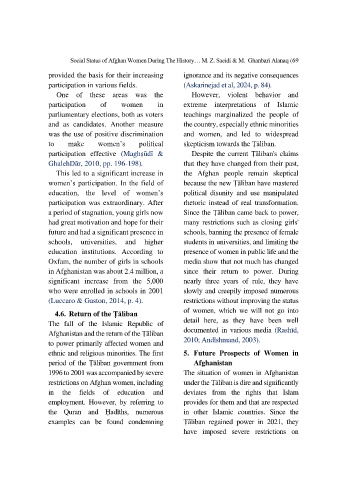Page 94 - Pure Life 40
P. 94
Social Status of Afghan Women During The History… M. Z. Saeidi & M. Ghanbari Alanaq (69
provided the basis for their increasing ignorance and its negative consequences
participation in various fields. (Askarinejad et al, 2024, p. 84).
One of these areas was the However, violent behavior and
participation of women in extreme interpretations of Islamic
parliamentary elections, both as voters teachings marginalized the people of
and as candidates. Another measure the country, especially ethnic minorities
was the use of positive discrimination and women, and led to widespread
to make women’s political skepticism towards the Ṭāliban.
participation effective (Maghṣūdī & Despite the current Ṭāliban's claims
GhalehDār, 2010, pp. 196-198). that they have changed from their past,
This led to a significant increase in the Afghan people remain skeptical
women’s participation. In the field of because the new Ṭāliban have mastered
education, the level of women’s political disunity and use manipulated
participation was extraordinary. After rhetoric instead of real transformation.
a period of stagnation, young girls now Since the Ṭāliban came back to power,
had great motivation and hope for their many restrictions such as closing girls'
future and had a significant presence in schools, banning the presence of female
schools, universities, and higher students in universities, and limiting the
education institutions. According to presence of women in public life and the
Oxfam, the number of girls in schools media show that not much has changed
in Afghanistan was about 2.4 million, a since their return to power. During
significant increase from the 5,000 nearly three years of rule, they have
who were enrolled in schools in 2001 slowly and creepily imposed numerous
(Luccaro & Gaston, 2014, p. 4). restrictions without improving the status
4.6. Return of the Ṭāliban of women, which we will not go into
The fall of the Islamic Republic of detail here, as they have been well
Afghanistan and the return of the Ṭāliban documented in various media (Rashīd,
to power primarily affected women and 2010; Andīshmand, 2003).
ethnic and religious minorities. The first 5. Future Prospects of Women in
period of the Ṭāliban government from Afghanistan
1996 to 2001 was accompanied by severe The situation of women in Afghanistan
restrictions on Afghan women, including under the Ṭāliban is dire and significantly
in the fields of education and deviates from the rights that Islam
employment. However, by referring to provides for them and that are respected
the Quran and Ḥadīths, numerous in other Islamic countries. Since the
examples can be found condemning Ṭāliban regained power in 2021, they
have imposed severe restrictions on

